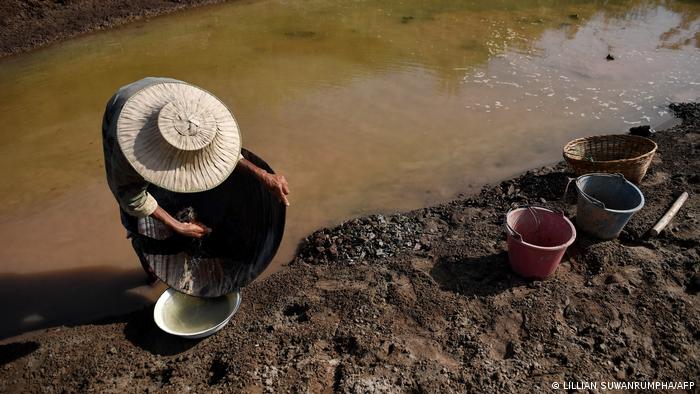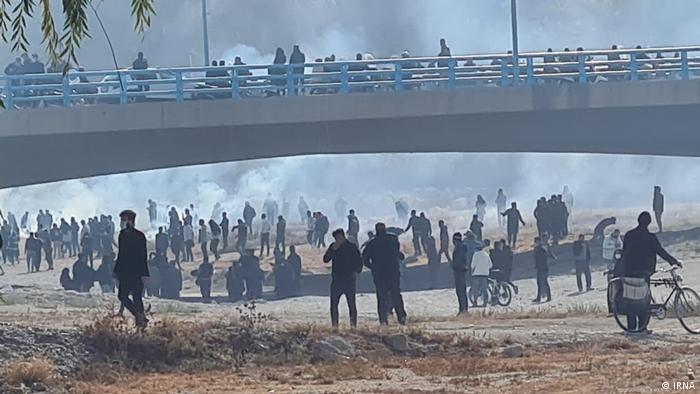Moscow announced that it had attacked a dam on North Crimean Canal during Russia’s invasion. After Russia annexed Crimea, Ukraine built the dam. This blocked the vital water supply to the occupied territory, leading to severe water shortages.
The conflict in Ukraine is not over Crimea’s water supply. But the Pacific Institute’s Water Conflict Chronology details examples of wateras a weapon, casuality or trigger of conflict going back millennia. Ashok Swain, professor of peace and conflict at Uppsala University in Sweden and former UNESCO chair for international water cooperation, says Crimea’s water supply is another example of this.
However, shared water resources can also provide an opportunity for cooperation. Ashok says that even in Crimea, if the international community had engaged Russia and Ukraine to resolve the humanitarian issue of water, it might have given them “a possibility or forum to negotiate, and to discuss how to deal with this issue and other issues.”
Water tensions
About 40% of the world’s population lives near rivers that cross international boundaries. The climate crisis has made it more difficult to share these vital resources fairly.
In February, the Grand Ethiopian Renaissance Dam finally turned on, despite continued objections from Egypt, Sudan, and others who have long feared the dam would have an impact on their farmlands further below the Nile.
Dams that have been built along the Mekong River in China have been blamed in part for the drought in Thailand and Cambodia. Tensions between India and Pakistan are rising over their shared Indus River basin waters.
The online tool Water Peace and SecurityThe World Resources Institute and others have created a map showing a world where tensions over water threaten to escalate into violence. Scott Moore, author of Subnational Hydropolitics, Conflict, Cooperation and Institution Building in Shared River basins, argues that this unrest occurs primarily within countries, not between them.
Moore states that international tensions about water rarely escalate to full-blown conflict. Even when disputes do flare, Moore says that water is often a proxy issue for other issues.
Moore states, “The intuition is water causes tension and conflicts. However, I would argue that it’s often the reverse where geopolitical tensions are translated into water.”
In the case of dams going up on the Mekong, for example, complex factors resulting in low waters levels in downstream countries can be downplayed in the face of China’s massive campaign on dam-building upstream. Moore stated, “There is increased anxiety among neighbouring countries about China’s growing strength, and I believe we see that reflected through water issues.”
Politics and drought in Middle East
Water shortages in Iran have fueled protests , dubbed the “Uprising of the Thirsty”, since last summer. Tensions are also rising in long-standing disputes that have erupted with Afghanistan over its Kamal Khan Dam, which is located upstream on the Helmand River.
Susanne Schmeier is an associate professor of water law, diplomacy, at IHE Delft, the Netherlands. She says that blaming neighboring nations for hoarding water can serve as a convenient diversion from domestic problems around water pricing and inefficient infrastructure.
Schmeier explains that Iran faces a strong domestic water crisis, which could include protests by farmers and conflicts between urban residents and farmers. “You also see strong statements from Iranian policymakers towards Afghanistan, saying, We want our fair share of this river.”
Iran accuses its neighbor upstream of hoarding water. However, it is also building dams on the Helmand and other rivers. This includes a tributary to the Tigris that flows into Iraq, which is facing water scarcity issues of its own.
Drought-stricken Iraq blames Turkey and Iran for its water woes. Turkey has dams on the Euphrates and the Tigris, and both Syria and Iraq claim that these dams are causing them to dry up.
Tensions are being exacerbated by climate change
Turkey had to release 500 cubic meters of Euphrates water per second to neighboring Syria when it was constructed in the 1980s. Turkey is blaming climate changes for the flow that is now well below its original levels. But Syrian Kurds from across the border believe Turkey is punishing their political rivals.
Swain states that tensions over Ethiopia’s GERD Hydropower are also rooted within a tangle geopolitical as well as climatic factors. The dam could be mutually beneficial in theory: Sudan and Egypt could benefit from its cheap electricity. The dam could also be used as a control point for the flow of the Nile, to avoid flooding like that which has devastated parts of Sudan in recent times.
However, the question is what would happen if Ethiopia has to hold back water for a few years? Swain states that this is why there is so much fear about climate change.
Water as a depoliticized’ topic
International cooperation regarding the Nile waters would be easier if the upstream and downstream countries were not on opposing sides of geopolitical divisions. Swain stated, “The world has split into two camps… Ethiopia is receiving support from China and Russia,” while Egypt and Sudan are more closely aligned to the West.
Yet Mehmet Altingoz, who researches transboundary management at the US University of Delaware believes focusing on the humanitarian issue of Crimea’s water supply could have helped diffuse tensions along precisely this global divide.
“NATO and West missed an opportunity for tensions to ease in the region by asking Ukraine to find a way of cooperating on water access to Crimea.” He argues in an article he co-authored.
“It’s simpler to cooperate over environmental assets,” he said to DW. His research also covered Turkey and Armenia. These countries have no diplomatic relations, but share ownership of a Soviet dam that lies on their dividing line.
Altingoz explains how every month a technical panel made up of members of rival nations meets in order to decide how water will go.
Water for cooperation and not conflict
The UN estimates that close to 300 international water treaties were signed since 1948. However, the majority of these treaties are rarely mentioned in the media.
“There are far more instances and examples and cases of cooperation over water especially if we define that in terms of international agreements dealing with the management of shared water resources than there are instances or cases or examples of conflict,” Moore said.
Though water tensions have regularly flared between India and Pakistan, the rival nations have worked together through the Indus Water Treaty, dating back to the 1960s, even as greater tensions ignited, Schmeier says: “India and Pakistan, even when they were at the brink of nuclear war, kept meeting under the treaty.”

The Danube, which has 19 countries in its basin, has been a source both of tension and cooperation throughout the ages.
She also mentions the stability pact, which worked to establish peace in the Balkans after war in the 1990s. It took the shared waters of Danube as a starting place for cooperation.
Schmeier stated that the countries reached an agreement and set up a river basin organisation. This brought them together. Then, trade and cleanup of war remnants and other things were possible.
Edited by Jennifer Collins




